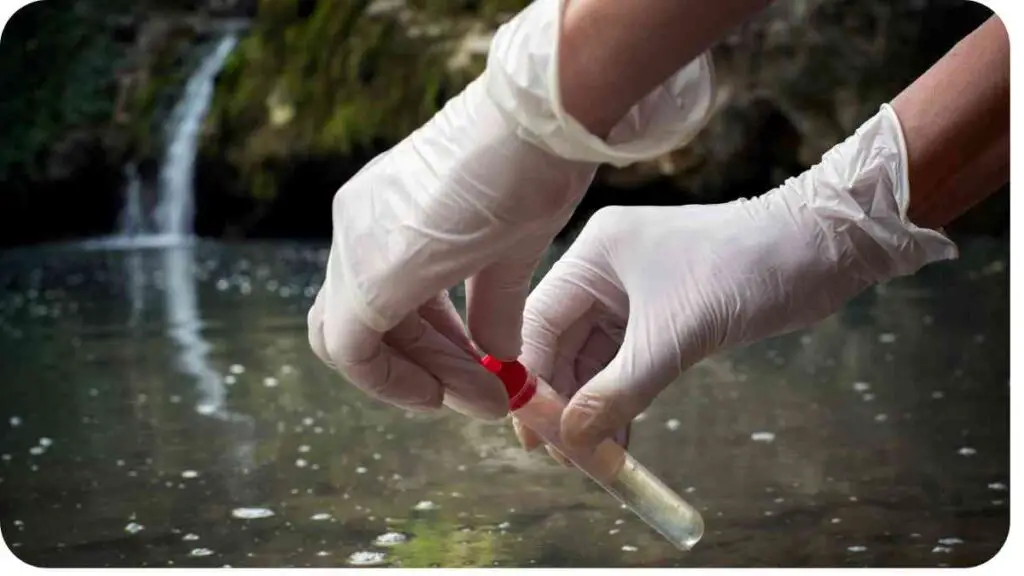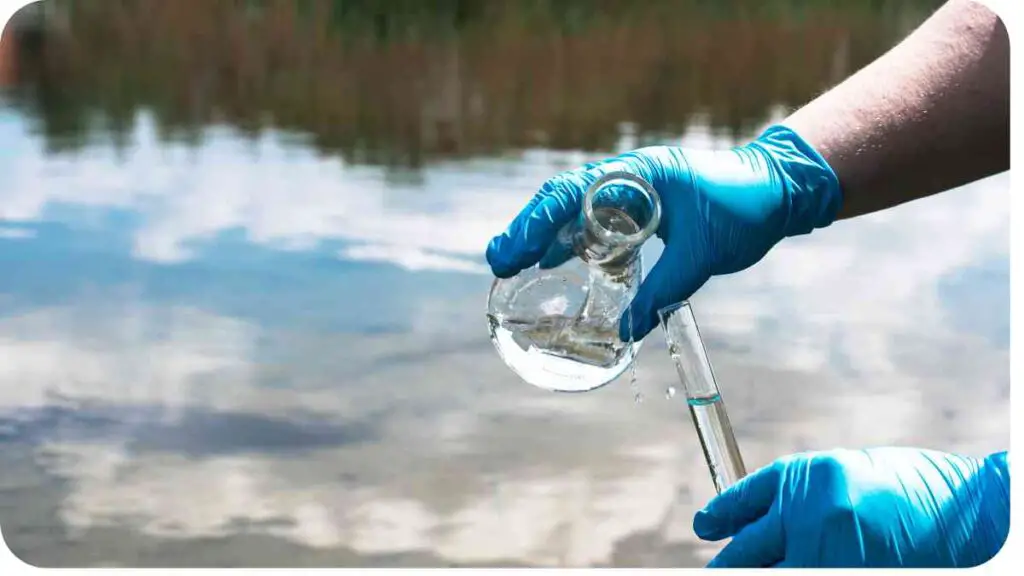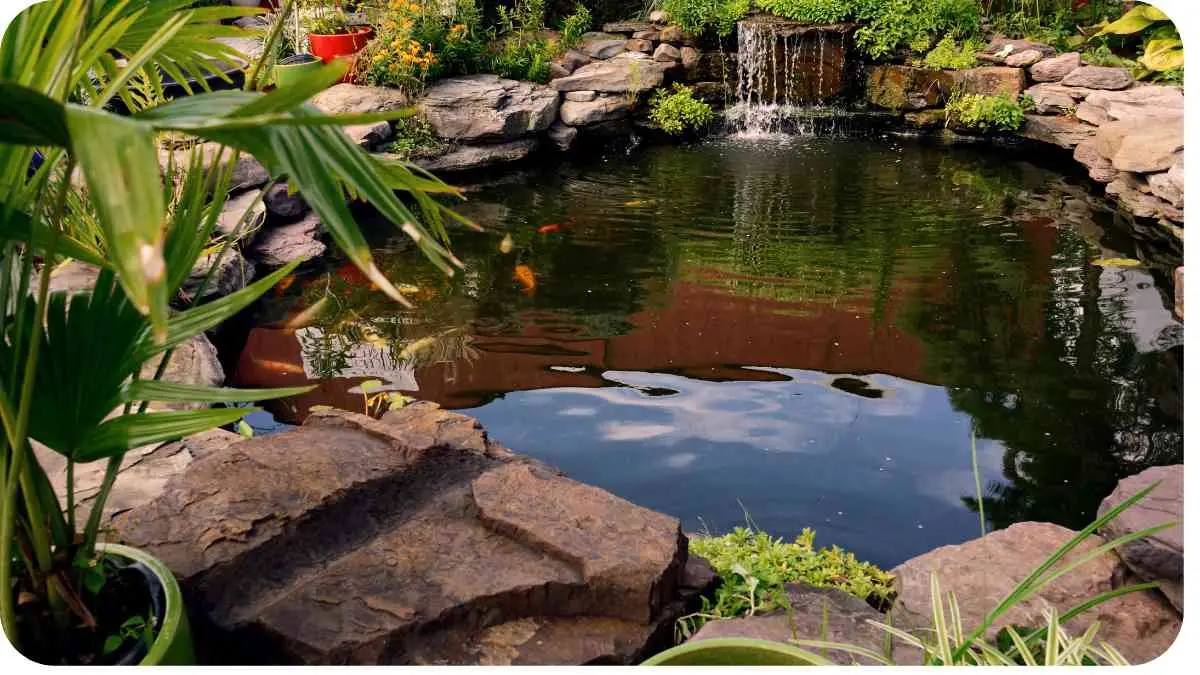Maintaining the quality of water in your pond is crucial for the health of aquatic life and the overall aesthetic appeal of your pond. However, various factors can lead to water quality issues, affecting clarity, odor, and the well-being of fish and plants. In this guide, we’ll delve into common pond water quality problems, their causes, and effective troubleshooting techniques.
| Takeaway |
|---|
| Understanding common pond water quality issues |
| Testing pond water quality parameters regularly |
| Identifying specific water quality problems |
| Implementing targeted solutions for each issue |
| Prevention is key to maintaining optimal water quality |
| Regular maintenance and monitoring are essential |
2. Understanding Common Pond Water Quality Issues

Pond water quality issues can arise due to a combination of factors, including organic waste buildup, nutrient imbalances, and inadequate filtration. Understanding the root causes of these problems is essential for effective troubleshooting.
When tackling fungal diseases, proper identification is crucial for effective treatment. Understanding the signs and symptoms can help prevent widespread damage to your garden.
Table: Common Pond Water Quality Issues
| Problem | Description |
|---|---|
| Algae Overgrowth | Excessive growth of algae, resulting in green water and reduced oxygen levels. |
| Green Water | Water appears green due to suspended algae particles, limiting visibility. |
| Murky Water | Cloudy or turbid water caused by suspended particles, sediment, or organic matter. |
| Foul Odors | Unpleasant odors emanating from the pond, often indicative of anaerobic decomposition. |
| Fish Health Issues | Signs of stress or disease among pond fish, including lethargy, lesions, and abnormal behavior. |
| pH Imbalance | Fluctuations in pH levels, impacting the overall balance of the pond ecosystem. |
| Nutrient Imbalance | Excessive nutrients, such as nitrogen and phosphorus, leading to algae blooms and water quality issues. |
| Oxygen Depletion | Insufficient oxygen levels in the water, endangering fish and other aquatic organisms. |
3. Testing Pond Water Quality
Before addressing any pond water quality issues, it’s essential to conduct comprehensive water testing to assess various parameters. Several test kits are available, allowing you to measure factors such as pH, ammonia, nitrite, nitrate, and dissolved oxygen levels.
Table: Essential Pond Water Parameters and Testing Methods
| Parameter | Description | Testing Method |
|---|---|---|
| pH | Measures acidity or alkalinity of the water | pH test kit |
| Ammonia | Indicates the presence of toxic ammonia | Ammonia test kit |
| Nitrite | Measures nitrite levels, harmful to fish | Nitrite test kit |
| Nitrate | Indicates nitrate levels, promoting algae | Nitrate test kit |
| Dissolved Oxygen | Measures oxygen available for aquatic life | Dissolved oxygen meter |
4. Identifying Pond Water Quality Problems

Identifying specific water quality problems is crucial for implementing targeted solutions. By observing physical characteristics and monitoring water parameters, you can pinpoint the underlying issues.
Don’t let pests overrun your garden oasis. Explore practical tips and tricks to combat infestations and keep your plants thriving in a pest-free environment.
Table: Signs and Symptoms of Common Pond Water Quality Problems
| Problem | Signs and Symptoms |
|---|---|
| Algae Overgrowth | Green, slimy algae covering surfaces; reduced oxygen levels; foul smell. |
| Green Water | Water appears green and opaque; limited visibility; excessive algae growth. |
| Murky Water | Cloudy or turbid water; difficulty seeing objects below the surface; sediment accumulation. |
| Foul Odors | Strong, unpleasant odors; often resembling rotten eggs; indicative of anaerobic conditions. |
| Fish Health Issues | Lethargic fish; abnormal behavior; lesions or sores; gasping at the water surface. |
| pH Imbalance | Fluctuations in pH levels; acidic or alkaline water; stress on fish and aquatic plants. |
| Nutrient Imbalance | Excessive algae growth; green water; foul odors; depletion of dissolved oxygen. |
| Oxygen Depletion | Gasping fish; surface agitation; excessive algae growth; foul odors; stagnant water. |
5. Algae Overgrowth
Algae overgrowth is one of the most common pond water quality issues, often fueled by excess nutrients and sunlight exposure.
Table: Types of Algae and Their Characteristics
| Type | Characteristics |
|---|---|
| Green Algae | Single-celled or filamentous; thrives in sunlight and nutrient-rich environments. |
| Blue-Green Algae | Cyanobacteria; can produce toxins harmful to fish and other aquatic organisms. |
| String Algae | Forms long, filamentous strands; can quickly cover surfaces and deplete oxygen levels. |
| Blanketweed | Forms dense mats on the water surface; inhibits oxygen exchange and blocks sunlight. |
6. Green Water
Green water is a common issue caused by suspended algae particles, leading to poor visibility and aesthetic concerns.
Is your garden suffering from poor drainage? Learn how to enhance its drainage to prevent waterlogging and create an optimal growing environment for your plants.
Table: Causes of Green Water and Solutions
| Cause | Solution |
|---|---|
| Excessive Nutrients | Reduce nutrient inputs from fertilizers and decaying organic matter; install aeration systems. |
| Inadequate Filtration | Upgrade to a more efficient filtration system; add UV clarifiers to kill algae cells. |
| Imbalance in Light and Shade | Plant floating or submerged vegetation to provide shade; limit direct sunlight exposure. |
| Algae Blooms | Treat with algaecides or barley straw extract; manually remove excess algae. |
7. Murky Water
Murky water is characterized by cloudiness or turbidity, often caused by suspended particles, sediment, or organic matter.
Table: Causes of Murky Water and Remedies
| Cause | Solution |
|---|---|
| Sediment Accumulation | Install sediment traps or settling ponds to capture suspended particles; regular pond maintenance. |
| Organic Debris Decomposition | Remove excess leaves, twigs, and organic matter from the pond; use beneficial bacteria additives. |
| Soil Erosion | Implement erosion control measures such as planting vegetation along the pond banks. |
| Algal Blooms | Address nutrient imbalances to prevent excessive algae growth; improve pond circulation. |
8. Foul Odors
Foul odors emanating from the pond can be off-putting and indicate underlying water quality issues.
Table: Causes of Foul Odors and Solutions
| Cause | Solution |
|---|---|
| Anaerobic Decomposition | Increase oxygen levels through aeration or circulation; add beneficial bacteria to promote decomposition. |
| Excessive Organic Matter | Remove decaying organic matter from the pond; prevent runoff containing pollutants. |
| Nutrient Overload | Implement nutrient management strategies; reduce fertilizer use near the pond. |
| Stagnant Water | Improve pond circulation with pumps or aerators; remove obstructions blocking water flow. |
9. Fish Health Issues
Maintaining optimal water quality is essential for the health and well-being of pond fish.
Witnessing wilting plants in your garden? Discover actionable steps to revive their vitality and restore their health with our comprehensive troubleshooting guide.
Table: Common Fish Health Issues and Remedies
| Issue | Remedies |
|---|---|
| Ammonia Poisoning | Perform partial water changes; add ammonia-neutralizing products; ensure proper filtration. |
| Nitrite Toxicity | Address high nitrite levels with water changes; use nitrifying bacteria supplements. |
| Oxygen Deprivation | Increase aeration and water circulation; remove decaying organic matter from the pond. |
| pH Fluctuations | Stabilize pH levels with buffering agents or pH-adjusting products; monitor water quality regularly. |
10. pH Imbalance

Fluctuations in pH levels can disrupt the delicate balance of the pond ecosystem, affecting both aquatic life and water quality.
Table: pH Levels and Their Effects
| pH Level | Effect |
|---|---|
| < 6 | Acidic conditions; harmful to fish and plants |
| 6-8 | Optimal range for most pond organisms |
| > 8 | Alkaline conditions; may stress aquatic life |
Maintaining pH within the optimal range is crucial for the health and vitality of pond inhabitants.
11. Nutrient Imbalance
Excessive nutrients, such as nitrogen and phosphorus, can fuel the growth of algae and other aquatic plants, leading to water quality issues.
Erosion threatening the integrity of your landscape? Dive into our comprehensive guide to eradicating erosion and safeguarding your outdoor spaces from the damaging effects of soil erosion.
Table: Effects of Nutrient Imbalance
| Nutrient | Effect |
|---|---|
| Nitrogen | Stimulates algae growth; depletes oxygen levels |
| Phosphorus | Promotes algae blooms; reduces water clarity |
| Potassium | Essential for plant growth; excessive levels can lead to imbalances |
Balancing nutrient inputs and implementing nutrient management strategies are essential for preventing algae overgrowth and maintaining water clarity.
12. Oxygen Depletion
Insufficient oxygen levels in pond water can be detrimental to fish, plants, and other aquatic organisms.
Table: Causes of Oxygen Depletion and Solutions
| Cause | Solution |
|---|---|
| Excessive Algae Growth | Control algae blooms through manual removal or algaecide treatment; increase aeration. |
| Overstocking | Reduce fish population to lessen oxygen demand; improve pond circulation with aerators. |
| Warm Water Temperature | Install shade structures to reduce water temperature; increase aeration during hot weather. |
| Decomposition of Organic Matter | Remove decaying organic matter; add oxygenating plants to increase oxygen production. |
13. Solutions for Pond Water Quality Problems
Addressing pond water quality issues requires a combination of proactive measures and targeted solutions tailored to specific problems.
Table: Solutions for Common Pond Water Quality Problems
| Problem | Solutions |
|---|---|
| Algae Overgrowth | Manual removal of algae; use of algaecides or barley straw extract; installation of UV clarifiers. |
| Green Water | Installation of UV clarifiers; optimization of filtration systems; shade provision for the pond. |
| Murky Water | Implementation of sediment traps; regular removal of sediment and organic debris; pond dredging. |
| Foul Odors | Increase aeration and circulation; removal of decaying organic matter; application of beneficial bacteria. |
| Fish Health Issues | Water quality testing and monitoring; proper nutrition and feeding practices; quarantine procedures for sick fish. |
| pH Imbalance | Addition of buffering agents or pH stabilizers; regular monitoring and adjustment of pH levels. |
| Nutrient Imbalance | Reduction of nutrient inputs; use of phosphate-binding products; implementation of aquatic plants for nutrient uptake. |
| Oxygen Depletion | Installation of aerators or fountains; removal of excess organic matter; management of fish stocking density. |
14. Prevention Tips
Preventing pond water quality problems is often more manageable than addressing existing issues. Implementing preventive measures can help maintain optimal water conditions and reduce the likelihood of problems occurring.
Table: Prevention Tips for Pond Water Quality Issues
| Tip | Description |
|---|---|
| Regular Water Testing | Monitor pH, ammonia, nitrite, nitrate, and oxygen levels regularly to detect changes early. |
| Adequate Filtration | Invest in high-quality filtration systems appropriate for your pond size and stocking density. |
| Nutrient Management | Limit fertilizer use near the pond; control runoff containing nutrients to prevent nutrient influx. |
| Proper Fish Stocking | Avoid overstocking the pond; maintain a balanced fish population relative to the pond’s capacity. |
| Maintenance of Surrounding Vegetation | Prevent leaves and debris from entering the pond; trim overhanging branches to reduce organic inputs. |
| Aeration and Circulation | Install aerators or fountains to increase oxygen levels and promote water circulation. |
| Regular Pond Maintenance | Conduct routine cleaning, sediment removal, and equipment maintenance to prevent water quality issues. |
15. Conclusion
Maintaining optimal water quality in your pond is essential for the health and well-being of aquatic life and the overall aesthetic appeal of your outdoor space. By understanding common pond water quality problems, conducting regular testing, and implementing proactive solutions, you can ensure a thriving ecosystem for your fish, plants, and other pond inhabitants.
Remember, prevention is key when it comes to pond maintenance. By implementing preventive measures and staying vigilant about potential issues, you can minimize the occurrence of water quality problems and enjoy a beautiful and healthy pond for years to come.
If you encounter persistent or severe water quality issues despite your best efforts, don’t hesitate to seek assistance from pond professionals or local aquatic specialists. They can provide tailored advice and solutions to address your specific concerns and restore balance to your pond ecosystem.
With proper care and attention, your pond can become a tranquil oasis and a source of joy for you, your family, and your visitors to enjoy for years to come.
Further Reading
- Troubleshooting Common Pond Problems: A Practical Guide: This comprehensive guide offers practical solutions for common pond problems, including water quality issues and troubleshooting tips.
- Most Common Pond Water Quality Issues and Fixes: Explore this blog post to learn about the most prevalent pond water quality issues and effective fixes to address them.
- Pond Solutions: Discover a range of solutions for pond maintenance and water quality improvement, including products and expert advice.
FAQs
What are the main causes of algae overgrowth?
Algae overgrowth can be caused by excess nutrients, sunlight exposure, inadequate filtration, and poor water circulation.
How can I prevent green water in my pond?
To prevent green water, consider installing UV clarifiers, optimizing filtration systems, providing shade, and controlling nutrient inputs.
What should I do if my pond water becomes murky?
If your pond water becomes murky, you can implement sediment traps, regularly remove sediment and organic debris, and consider pond dredging if necessary.
How do I address foul odors coming from my pond?
To address foul odors, increase aeration and circulation, remove decaying organic matter, and apply beneficial bacteria to promote decomposition.
What steps can I take to maintain fish health in my pond?
Maintain proper water quality through regular testing and monitoring, provide balanced nutrition, practice proper quarantine procedures for sick fish, and avoid overstocking the pond.

Hi! My name is Hellen James, and I’m here to help you with your home-maintenance needs. Whether it’s building a better yard or just trying to fix a garden—I can show you how.


